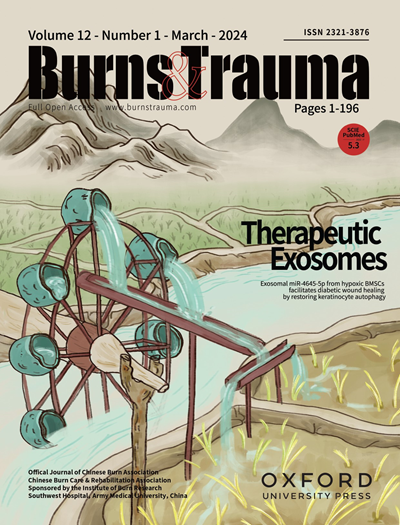Enhancing diabetic muscle repair through W-GA nanodots: a nanomedicinal approach to ameliorate myopathy in type 2 diabetes
IF 9.6
1区 医学
Q1 DERMATOLOGY
引用次数: 0
Abstract
Objective Type 2 diabetes mellitus (T2DM) is a chronic metabolic disorder that significantly impairs muscle regeneration following injuries, contributing to numerous complications and reduced quality of life. There is an urgent need for therapeutic strategies that can enhance muscle regeneration and alleviate these pathological mechanisms. In this study, we evaluate the therapeutic efficacy of W-GA nanodots, which are composed of gallic acid (GA) and tungstate (W6+), on muscle regeneration in type 2 diabetes mellitus (T2D)-induced muscle injury, with a focus on their anti-inflammatory and antioxidative effects. Methods This study synthesized ultrasmall W-GA nanodots that were optimized for improved stability and bioactivity under physiological conditions. In vitro assessments included cell viability, apoptosis, reactive oxygen species (ROS) generation, and myotube differentiation in C2C12 myoblasts under hyperglycemic conditions. In vivo, T2D was induced in C57BL/6 mice, followed by muscle injury and treatment with W-GA. Muscle repair, fibrosis, and functional recovery were assessed through histological analysis and gait analysis using the CatWalk system. Results The W-GA nanodots significantly enhanced muscle cell proliferation, decreased ROS, and reduced apoptosis in vitro. In vivo, compared with the control group, the W-GA-treated group exhibited notably improved muscle regeneration, decreased fibrosis, and enhanced functional recovery. The treatment notably modulated the inflammatory response and oxidative stress in diabetic muscle tissues, facilitating improved regenerative dynamics and muscle function. Conclusions W-GA nanodots effectively counter the pathological mechanisms of diabetic myopathy by enhancing regenerative capacity and reducing oxidative stress and inflammation. This nanomedicine approach offers a promising therapeutic avenue for improving muscle health and overall quality of life in individuals suffering from T2D. However, further studies are needed to explore the clinical applications and long-term efficacy of these nanodots in preventing diabetic complications.通过W-GA纳米点增强糖尿病肌肉修复:改善2型糖尿病肌病的纳米医学方法
2型糖尿病(T2DM)是一种慢性代谢紊乱,在损伤后显著损害肌肉再生,导致许多并发症和生活质量下降。目前迫切需要能够促进肌肉再生和减轻这些病理机制的治疗策略。在这项研究中,我们评估了由没食子酸(GA)和钨酸盐(W6+)组成的W-GA纳米点对2型糖尿病(T2D)诱导的肌肉损伤的治疗效果,并重点研究了它们的抗炎和抗氧化作用。方法合成了在生理条件下稳定性和生物活性得到优化的超小W-GA纳米点。体外评估包括高血糖条件下C2C12成肌细胞的细胞活力、凋亡、活性氧(ROS)的产生和肌管分化。在体内,在C57BL/6小鼠中诱导T2D,然后进行肌肉损伤和W-GA处理。通过使用CatWalk系统的组织学分析和步态分析来评估肌肉修复、纤维化和功能恢复。结果W-GA纳米点能显著促进肌肉细胞增殖,降低ROS,减少细胞凋亡。在体内,与对照组相比,w - ga处理组肌肉再生明显改善,纤维化减少,功能恢复增强。该治疗显著调节了糖尿病肌肉组织的炎症反应和氧化应激,促进了再生动力学和肌肉功能的改善。结论W-GA纳米点通过增强再生能力、减少氧化应激和炎症反应,有效对抗糖尿病肌病的病理机制。这种纳米医学方法为改善肌肉健康和T2D患者的整体生活质量提供了一种有希望的治疗途径。然而,这些纳米点在预防糖尿病并发症中的临床应用和长期疗效还需要进一步的研究。
本文章由计算机程序翻译,如有差异,请以英文原文为准。
求助全文
约1分钟内获得全文
求助全文
来源期刊

Burns & Trauma
医学-皮肤病学
CiteScore
8.40
自引率
9.40%
发文量
186
审稿时长
6 weeks
期刊介绍:
The first open access journal in the field of burns and trauma injury in the Asia-Pacific region, Burns & Trauma publishes the latest developments in basic, clinical and translational research in the field. With a special focus on prevention, clinical treatment and basic research, the journal welcomes submissions in various aspects of biomaterials, tissue engineering, stem cells, critical care, immunobiology, skin transplantation, and the prevention and regeneration of burns and trauma injuries. With an expert Editorial Board and a team of dedicated scientific editors, the journal enjoys a large readership and is supported by Southwest Hospital, which covers authors'' article processing charges.
 求助内容:
求助内容: 应助结果提醒方式:
应助结果提醒方式:


